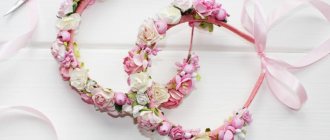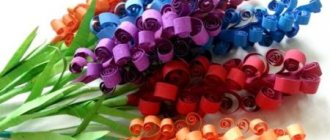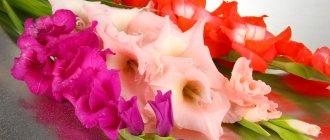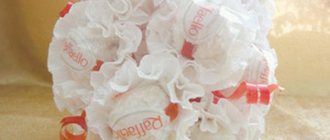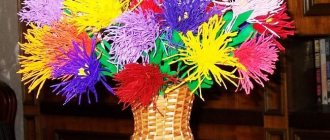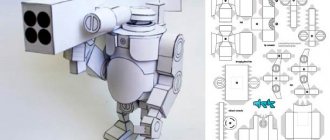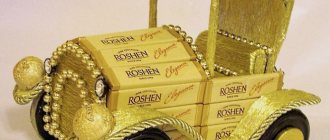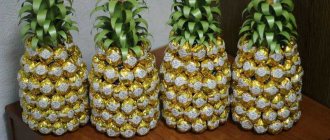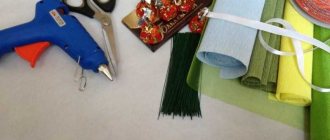The ancestral country of Kusadama is Japan. This technique belongs to a subtype of origami consisting of modules. Craftswomen have now learned to create unique masterpieces of art by connecting paper modules together.
Ball-shaped crafts made using this technique perfectly create a special airy atmosphere in modern interior design, set the tone of abstract mystery, arousing the interest of an increasing number of people.
DIY paper bags for flowers, seeds and sweets
Sometimes it’s quite difficult to decide how to make a paper bag. There are several simple but diverse manufacturing schemes that have their own characteristics, advantages and disadvantages. The simplest option in terms of manufacturing is a regular bag for seeds. But there are more interesting solutions that can be implemented without much effort.
Assembly technique
The method of joining the workpieces determines the external contours of the product:
- to assemble flat elements, the connection occurs by inserting the corners of one module into the pockets of another,
- to create the base of a figure or chain, the top is joined to the pocket, the parts are inserted sequentially, one after another,
- if during construction it is necessary to connect 3 modules, then the tops of 2 parts are placed in the pocket of the 3rd one,
- poisons are formed by stringing an element onto adjacent corners of the triangles of the bottom row.
Having prepared a sufficient number of small paper structures, you can begin modeling.
You can calculate the required number of modules from the photograph. You need to count all visible elements, multiply their number by 3 and subtract 15% from the resulting figure. The total amount is the approximate number of “spare parts” needed for assembly.
How to make a paper bag
There are several schemes for how to make a paper bag - it all depends on the desired shape and features of use. Mostly cone-shaped bags are used, but there are also more universal types of design that can replace a bowl or glass.
There are other principles for the formation of “containers”, which differ in their appearance, strength and functionality.
Required materials and tools
You can make a paper bag using different assembly patterns. But first you need to decide for what purpose the product will be used. The main material is selected in accordance with functionality. For example, beautiful bags are mainly used as packaging, so you should choose paper or cardboard with an interesting print to make them. If this is temporary storage, then regular white cellulose or even newspaper will do.
In any case, you should use thick paper so that the bag holds its shape.
Step-by-step assembly for beginners
There is the simplest diagram on how to roll a paper bag with your own hands. It is enough to use a simple algorithm:
According to the standard, this is a paper bag for seeds, but you can also use it for other bulk products. The manufacturing process will take 1-2 minutes, and if you practice, even a few seconds.
Crane - origami
One of the simplest models, it is believed that if you collect 1000 cranes, your most cherished wish will come true.
Step-by-step instructions for making an origami crane look like this:
- Bend the paper sheet diagonally.
- We take scissors and cut off all the excess, in the end there should be a triangle left.
- Let's make one more fold.
- From the resulting triangle (one, since there will be 2 of them), we make a square using the straightening method. On the other hand, we repeat the procedure.
- Take the edges from above and gently bend them towards the center.
- Bend the triangle located on top.
- We unbend it, we form a contour.
- Bend the lowest corner horizontally.
- Fold the edges towards the center to form a diamond shape. We repeat all steps on the other side.
- Take it by the bottom and bend it along the inner counter. The result is a neck.
- We also make a tail.
- At the neck, carefully bend the beginning to obtain a beak.
- We bend the wings using a slight angle.
The crane is ready, you can color it if you wish.
Using Petals
If there are still a lot of petals left after shedding, you can find other useful uses for them. They are perfect for showering the wedding bed and can create a romantic atmosphere.
With the help of petals you can decorate a banquet hall, as well as a wedding procession. One of the best options is to use petals during a photo shoot; any skilled photographer will be able to take successful shots in which the newlyweds will stand surrounded by floating pink petals.
This wonderful tradition creates an amazing festive atmosphere that reigns throughout the day.
Modular origami technique
To create modular origami, you can use a special guide, which already contains the necessary templates, or develop your own templates. The modules are made by folding sheets of paper as desired. In this case, special recesses and pockets are provided to ensure the connection of the modules with each other.
Sometimes another additional shape can be created inside a figure. Its function is to create anchor points and strengthen the structure. Although, according to some experts, such a finished project can no longer be considered an illustrative example of modular origami.
What to make it from?
To build bags at home with your own hands, you will need any thick cardboard. A piece of cardboard is rolled up and glued together. This will be the basis of the blank, thick paper can be of any color, after which the accessory is decorated depending on the style of the celebration. The decor itself depends only on imagination, preferences and the theme of the holiday.
How to make a keychain with your own hands - many master classes and creative photo ideas
Knitted overalls for newborns - choosing a model, patterns, tips for beginners
Assembly technique
The method of joining the workpieces determines the external contours of the product:
- to assemble flat elements, the connection occurs by inserting the corners of one module into the pockets of another,
- to create the base of a figure or chain, the top is joined to the pocket, the parts are inserted sequentially, one after another,
- if during construction it is necessary to connect 3 modules, then the tops of 2 parts are placed in the pocket of the 3rd one,
- poisons are formed by stringing an element onto adjacent corners of the triangles of the bottom row.
Having prepared a sufficient number of small paper structures, you can begin modeling.
You can calculate the required number of modules from the photograph. You need to count all visible elements, multiply their number by 3 and subtract 15% from the resulting figure. The total amount is the approximate number of “spare parts” needed for assembly.
Manufacturing recommendations
- In order to make a decent little bag, you need to use thick crepe paper, you can also take scrapbooking paper.
- This accessory can be made from fabric that must have a certain density.
- The top of the bag can be made into a shape; all you need to do is use scissors and your own imagination.
- You can write the date and names of the newlyweds on the bag; after crumbling, the empty bags can be distributed to guests as a reminder of the wedding.
- It is best to prepare the petals the day before the celebration to ensure they remain fresh and fragrant.
- To quickly cut out a cone, use a ready-made bag template for rose petals.
The bags will emphasize the festivity and solemnity of the event; they can also be used to sprinkle birthday gifts and for discharge from the maternity hospital.
The legend of the origin of “medicine balls”
There are legends that in ancient Japan, kusudama was used as lamps for burning incense and mixing dried flowers. This was part of the traditional ritual. The name itself seems to be divided into two words, and together they can be translated as “medicinal ball”
No one knows whether this legend is true, but we all know for sure that looking at beauty is good for health. It turns out that the truly mysterious ball has the ability to have a beneficial effect on well-being. Nowadays, this art is used to decorate the home or often as a gift.
Edible men's cascading bouquet
- Hunting sausages – half a kilogram
- Cheese braid – 1 piece
- Beer (0.5 l capacity) – 3 bottles
- Nuts – 4 packs (weighing 60 grams each)
- Cherry tomatoes – 9 pieces
- Capsicum – 3 pieces
- Rosemary in sprigs – 3 pieces
And available materials (ask for them in florist shops):
- Mica 25*30 cm
- Ribbon or decorative for tying a bouquet and its elements
- Wooden skewers 15 cm long (you can use sushi chopsticks)
- Scotch
- The tape is better green (since we will use it to attach the greens to the skewers)
- Transparent film for flowers
- Paper for wrapping bouquets
- Ribbon for tying a bouquet
Preparing products for an edible men's bouquet with your own hands.
Please note that everything must be done with very clean hands or gloves. Pour vegetables into a plate. Do not wash! Otherwise, they may leak already in the bouquet. Vegetables are washed immediately before consumption.
Just wipe with a cloth, you can gently rub until shiny. You need to do this especially carefully with tomatoes so that they don’t burst.
Now we need to prepare the cheese braids. We cut them into 2 halves. Pay attention to the ligament where the ends of the braid are with a whisk. Cut so that they remain together, otherwise everything will fall apart.
We cut the hunting sausages to about 5 cm.
Thread each sausage and both pieces of cheese onto skewers. The cheese is heavier, so we string it onto 2 skewers.
We string small tomatoes into 3-4 pieces. Large ones, one at a time.
We also put peppers on skewers.
We wipe down beer bottles thoroughly.
Take a beer bottle, glue a small piece of tape, place a skewer and secure it with tape. And in this way you need to glue about 8 skewers. The distance between the skewers is 2-3 cm wide. In this case, the skewers should be located just below the middle of the bottle in height. So that the label is visible.
Now we wrap the tape over the skewers several times. This needs to be done very tightly, literally pulling the tape. So that everything holds tight.
Wrap the tape until all skewers intersect. We process all 3 bottles in this way.
Cut the rosemary into umbrellas or panicles. And glue it to the skewers. But first we wrap the skewer with tape, and then we wrap the cut rosemary.
How to make a bag for an edible bouquet for men
We twist the mica into a triangular bag. And tape it on the side.
We place the mica bag on the stand. Pour nuts or popcorn or something else into it.
Let's tie it up. And insert a wooden skewer into the middle of the bag.
We cut the ends of the rope and wrap the base with tape. Thus, make several bags for an edible man's bouquet.
Making a beautiful ball
Now that we have a large set of “spare parts” in front of us, we begin to create our own modular creation. The first three rows will consist of seven modules with a beautiful alternation of colors.
It’s worth immediately sharing advice from those who have already thoroughly mastered origami: if the New Year’s ball is used for decoration or a gift, and children want to hold it in their hands, it is better to glue each row - this is a guarantee that the modular product will maintain its integrity.
In the fourth year, it is worth using fourteen modules, putting new blanks on each of the corners of the previous row. In the fifth row, seven more triangles will be added - the first of them is put on two corners of the previous row, and the next two are put on one corner of each of the modules of the previous row. Then again one module is put on two corners, then again one at a time and so on.
From the sixth to the fifteenth row we keep 21 modules in each, but starting from the sixteenth row, we again begin to reduce the number of “triangles” by seven pieces, that is, each one is already put on three corners of the previous row. This way you will gradually create an original Christmas ball.
All that remains is to glue a beautiful bow to it. It will be great if you create a whole set of these multi-colored balls using the origami technique. On the Christmas tree, these handmade products will look more original than store-bought toys. Modular creativity can be improved by creating other New Year's masterpieces.
This is interesting
The first New Year's balls can be considered apples, which in northern Europe were used to decorate a Christmas tree for the winter solstice. Along with sweets, fruits were considered sacrifices to the gods and guardian ancestors. Red apples were always chosen, since this color was considered protective, protecting against evil spirits. Later, with the advent of Catholicism, the tree became an analogue of the tree of the knowledge of good and evil from the Garden of Eden. And the apples, accordingly, depicted the very ones with which Eve tempted Adam before the Fall.
The tradition of decorating the New Year tree with edible “toys” lasted until the mid-19th century. The first glass figurines were made in the German city of Lausch (Thuringia) in 1848. According to legend, local craftsmen, previously famous for their magnificent tableware, switched to Christmas tree decorations due to a poor apple harvest. At first, only balls were made, which, firstly, were supposed to replace popular fruits, and secondly, they were easier to blow than other figures. A solution of silver nitrate gave the toys a festive shine; in addition, they were decorated with sparkles and carved overlays.
For many of Lausch's hereditary glassblowers, the production of Christmas tree decorations became the main occupation that brought in a good income. In 1867, a gas plant was built in the city, which made it possible to produce not only balloons, but also molded decorations: figurines of Santa Claus, snowmen, birds, animals, angels, and so on.
In Russia, the first enterprise for the production of Christmas tree decorations was founded in Klin (Moscow region) after the First World War. The initiators were captured German glassblowers, who shared the secrets of their craft with Russian craftsmen.
In 2008, one of Lausch’s private factories produced the three most expensive New Year’s balls in the world, costing €20,000 each. The jewelry was covered with gold openwork interspersed with diamonds. And a year later, the old German enterprises lost the palm to British jewelers from Hallmark Jewelers. They presented a mini-series of Christmas tree decorations made of white gold, which were decorated with over 1,500 diamonds. The cost of one copy exceeded €96,000.

